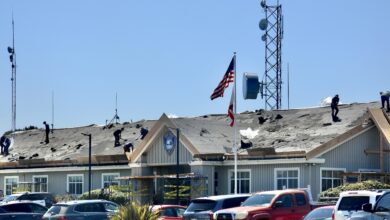PG&E responds to WaveConnect testing questions
When Pacific Gas & Electric surprised locals with a wave energy claim off Fort Bragg last February, they expected to get their money and permit well before the end of 2007.
The money is $6 million from the California Public Utilities Commission to fund studies of their twin projects off Eureka and Fort Bragg, called WaveConnect.
As the one-year anniversary approaches, the utility awaits both granting of its preliminary permit application and its funding.
After granting two dozen, the Federal Energy Regulatory Commission stopped granting preliminary permits about the time PG&E applied so that the federal agency could better assess issues such as permit banking, a kind of speculation in ocean real estate.
FERC now considers that rethinking process finished and a spokeswoman said FERC could grant the PG&E permit at any time, which would begin a three-year study and experimental device in the water.
WaveConnect
WaveConnect would test multiple ocean-powered technologies from up to four manufacturers, an array of devices connected to one transmission cable. PG&E hopes that the discharge from the city wastewater plant can be used for a cable to take the power to the PG&E power station in Fort Bragg, its FERC application states.
PG&E is seeking the exclusive three-year right to study 68 square miles off Fort Bragg. The area is 17 miles north to south by 4 miles wide, starting about one-half mile off the Mendocino Coast and extending up to 6 miles offshore.
WaveConnect funding has become controversial with the California Public Utilities Commission, as PG&E has been challenged by Independent Energy Producers and the Office of Ratepayer Advocates on its plan to keep research findings secret.
The debate before the PUC also involves whether PG&E should invest its own money in alternative energy projects. The Office Ratepayer Advocates has asked that WaveConnect be stricken from a bevy of alternative energy projects sought by PG&E as inappropriate public funding of private research.
PG&E responds to newspaper
PG&E spokeswoman Jennifer Zerwer responded to questions by this newspaper about how the effort to keep information from the public jibes with PG&E”s promises for a process distinguished by its openness.
“PG&E does support an open and transparent process. Any information that will be valuable to stakeholders as a group will be made public, such as environmental impact studies,” Zerwer said.
“While it”s unlikely that any intellectual property will result from the demonstration project (most IP will be developed in the [research and development] phase by the company that owns the wave conversion technology), if there is, it will belong to PG&E”s customers and they would benefit from any licensing of that intellectual property. Companies that want to use intellectual property belonging to customers, including PG&E shareholders or IEP members, would need to pay a fee to use that IP,” Zerwer said.
She said a draft decision is anticipated at the end of January and PG&E anticipates a final decision from the PUC in February.
Last summer, Fort Bragg City Councilman Dan Gjerde asked a PG&E representative if the utility would help pay for the 20 percent local match for the long-desired Noyo Harbor breakwater, which has been approved for federal funding.
Zerwer gave the same answer as the agency gave a year ago. “PG&E is in the very beginning stages of this process and we are working to understand the access issues at Noyo Harbor and will continue to solicit stakeholder input as well as conduct our own feasibility studies.”
She said PG&E has had no involvement in the GreenWave project located immediately to the south, off Mendocino, which was filed in October. The backers of that project have yet to make any overture to the community.
“GreenWave”s project is independent and unrelated to PG&E”s WaveConnect project. The locations are separate albeit adjacent,” Zerwer said.
With FERC and sister federal agency the Minerals Management Service feuding over who controls wave energy projects more than 3 miles offshore, PG&E hopes to work with both federal agencies. Both will be at Saturday”s wave energy forum, 9 a.m. to 4 p.m. at the Dana Gray Elementary School Multipurpose Room, 1197 Chestnut St., in Fort Bragg.
“PG&E has filed nominations with MMS for those portions of our WaveConnect projects that fall outside the three nautical mile boundary. However, it is important to note that wave energy is a nascent industry and the permitting processes continue to evolve,” Zerwer said
What does PG&E hope to get out of the Fort Bragg event?
“The event … is an educational event, which will include presentations from regulatory agencies, among others. PG&E looks forward to sharing the information we have available to date on the status of the preliminary permitting process. More importantly, we look forward to listening to community,” Zerwer said.
In addition to WaveConnect off Fort Bragg, PG&E has also filed for another WaveConnect off Eureka, with the study area about twice as big. PG&E recently entered into a contract to buy wave energy from a separate Eureka project.
Zerwer was asked if PG&E developed an opinion about whether Fort Bragg or Eureka WaveConnect is more ready to go forward.
“PG&E is in the preliminary permitting stages of the WaveConnect projects, conducting the initial impact assessments. As such, it is premature for us to determine which location we would move forward with first, if any. We think both locations are very promising in regards to the amount of clean, renewable electricity that could be generated from waves due to their depth proximity to shore,” Zerwer said.




